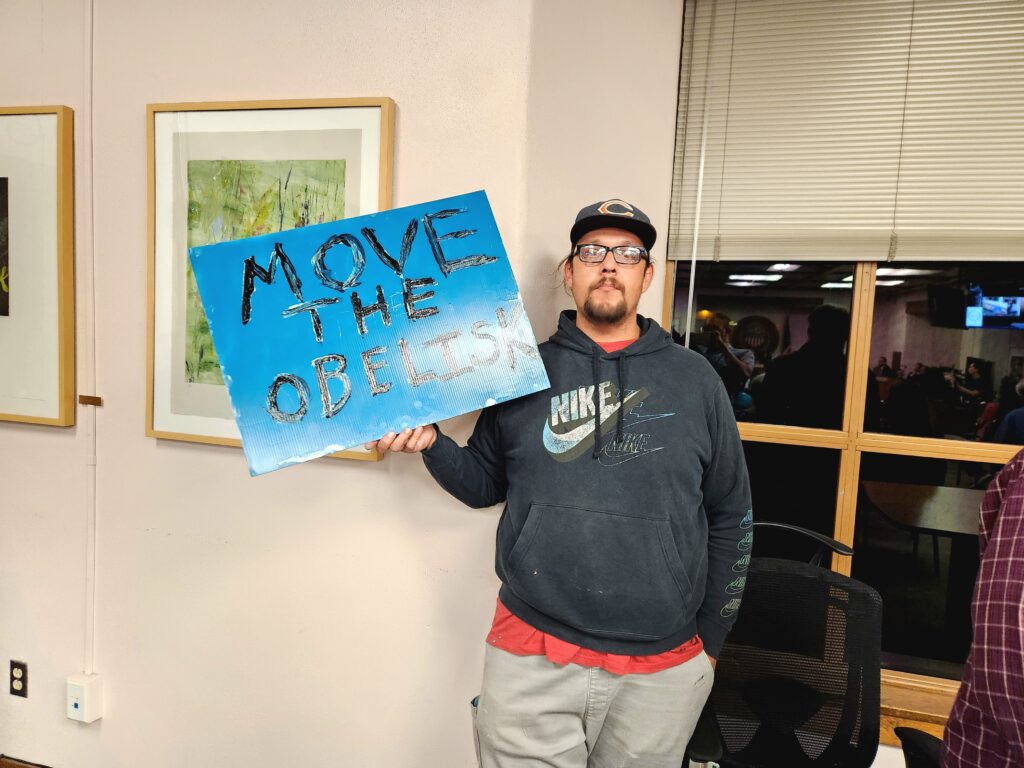Pascual Hernandez stands in silent protest in support of a proposal to move the Soldier’s Monument away from the Santa Fe Plaza to the Santa Fe National Cemetery during a Santa Fe City Council meeting on Sept 25, 2024. (Photo by Austin Fisher / Source NM)
Santa Fe’s local elected officials on Wednesday night declined to make a final decision about what to do with the controversial Soldier’s Monument, known as the obelisk.
With such sharp division among the community members in attendance and an ongoing court battle over the obelisk’s fate, the Santa Fe City Council voted to postpone any final decision until their next meeting on Oct. 30.
During the wave of social unrest in 2020, demonstrators tore the obelisk down with rope, and argued it represents a celebration of the destruction and subjugation of Native people. The monument’s base remains in place, covered by a wooden box, some plants and a sign giving context about it for curious visitors and locals. The damaged upper sections of the monument are being held in storage, though their location is a closely guarded secret.
Mayor Alan Webber and the Council’s eight other voting members could not reach an agreement after an hour-and-a-half of debate on a proposal by Councilor Carol Romero-Wirth to study the possibility of moving the monument to the Santa Fe National Cemetery near Rosario Hill on the city’s north side.
“We have got to figure out a way forward,” Romero-Wirth said. “This proposal is one way, one path, that we can take to get beyond the events of 2020 when the obelisk came down.”
The first people to make public comments Wednesday night were local resident Carrie Wood (Diné), a member of the Santa Fe Indigenous Center’s board of directors, and her family. They supported Romero-Wirth’s proposal.
“I want to remind you that the Native community in and around Santa Fe are against the obelisk, and do not want it on the Plaza,” Wood told the councilors. “We have made that clear many, many times, so I’m not sure why we have to keep restating that. Our stance on this hasn’t changed.”
Moving the monument would require the city to work alongside state and federal officials to formally ask the cemetery to accept the monument. The cemetery’s director has already said it’s something they would consider, Romero-Wirth said.
“I think we all agree the statue, as is, is unacceptable,” said Webber. “The only path forward is compromise.”
Romero-Wirth said she believes the monument can be either rebuilt or moved to the cemetery, near the graves of Union soldiers who fought in the American Civil War. She said that would place the monument in a more appropriate context. When her constituents brought the idea to her in Spring 2023, she said she thought the community was too polarized to accept it.
What changed her mind, she said, was the near-fatal shooting of a climate activist later in 2023, about 23 miles north in the city of Española, at the site of another controversial monument. Demonstrators gathered in opposition to Rio Arriba County plans to resurrect a statue depicting the genocidal Spanish conquistador Juan de Oñate. It had been removed by government officials in 2020. The shooter’s trial is set to begin on Oct. 7.
Judge to decide whether police use-of-force expert can testify in 2023 Oñate shooting trial
In Santa Fe that year, Webber declared an emergency in June 2020, saying that continued prominent display of the obelisk and two other monuments in the city, without public debate about their appropriate treatment and context, “perpetuates systemic racism, civil unrest, and may lead to violence.”
Earlier this year, in sworn testimony in court, Webber said at the time he believed the city was facing the possibility of civil unrest, due to reports of imminent demonstrations and counter-protests at monuments.
That danger remains today, Romero-Wirth said.
“I strongly believe we can’t put the obelisk back up in the middle of the Plaza,” she said on Wednesday. “It presents a potential public safety threat. As a result, this idea seemed like something that we should pursue.”
Offensive plaque has to go
Even without official action, council members appeared to reach agreement on one thing: A bronze plaque containing a racist description of Native American people has to go.
The plaque included offensive language dedicating the monument to “the heroes” who fought “savage Indians.”
The plaque was one of four placed on the obelisk’s stone base at each compass direction, paid for by New Mexico’s Territorial Legislature, before statehood.
The Soldier’s Monument was originally built to commemorate both the American soldiers who fought both in the U.S. Civil War, and wars against Indigenous tribes.
That’s according to sworn testimony in court from David Rasch, a museum collections consultant and a former historic preservation officer for the city of Santa Fe.
He was the expert witness in the ongoing civil lawsuit over the monument. Rasch was hired by the Union Protectiva de Santa Fe, a fraternal organization suing the city government to try to force the obelisk’s restoration in its original location, and whose members on Wednesday night called for the same.
Judge hears closing arguments in Obelisk trial
The deadline for written arguments to the judge is Friday. A member of the public and a city councilor said it might not be a good idea to make a final decision on the monument before the case is resolved.
One of the city’s arguments in the case is that they haven’t violated the law at issue — because the city government hasn’t made a final decision on the matter.
“How does the lawsuit that we’re in affect any of these decisions?” asked Councilor Lee Garcia. “If we were to come up with a consensus on a direction here, and there’s a different opinion coming from our courts … I would definitely be in support of whatever decision that is, as long as it’s fair in judgment.”

